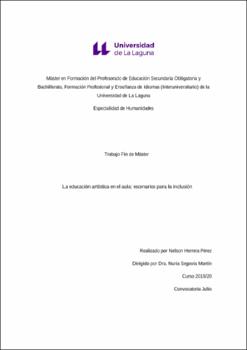La educación artística en el aula: escenarios para la inclusión
Autor
Herrera Pérez, NelsonFecha
2021Resumen
La atención a la diversidad y la inclusión son entendidas como las características
principales de nuestro sistema educativo actual. Los centros educativos, han impulsado
la innovación en la educación al ser preciso adaptar el método de enseñanza a los distintos
ritmos de aprendizaje y la diversidad funcional del alumnado. Esto ha posibilitado que el
alumnado con NEE (Necesidades Educativas Especiales) pueda superar las barreras del
aprendizaje tradicional, gracias a un apoyo específico reconocido en el marco legal que
regula la educación en nuestro país, adaptándose para ello los contenidos y el currículo
académico a sus necesidades especiales.
Sin lugar a duda, las TICs han supuesto un cambio revolucionario, convirtiéndose en uno
de los principales apoyos de estas nuevas metodologías educativas, favoreciendo su
accesibilidad a todo el alumnado, independientemente de los distintos grados y
capacidades personales de orden físico, psíquico, cognitivo o sensorial.
La educación artística, también ha sufrido una revisión de los modelos de aprendizaje,
experimentándose con novedosas experiencias apoyadas en las innovaciones
tecnológicas. A su vez, los museos se han ido adaptando a modelos más inclusivos,
facilitando la accesibilidad a su colección y diseñando programas para el público con
diversidad funcional. Todas estas medidas han ido transformando nuestra manera de
acercarnos al arte. Attention to diversity and inclusion are understood as the main characteristics that define
our current educational system. The education centers have promoted innovation in
education by adapting the teaching method to the different paces of student learning and
the functional diversity of students. This has enabled students with SEN (Special
Educational Needs) to overcome the obstacles of traditional learning, thanks to specific
support recognized in the legal framework that regulates education in our country. The
content and the academic curriculum has been adapted to their special needs.
4
ICT tools have brought about a revolutionary change, becoming a fundamental support
for these new educational methodologies, facilitating their accessibility to all students,
regardless of the different degrees and personal capacities of a physical, psychological,
cognitive or sensory nature.
Art education has also gone through a review of learning models after the experimentation
of novel experiences supported by technological innovations. Likewise, museums have
been adapting to more inclusive models, facilitating accessibility to their collection and
designing programs for the public with functional diversity. All these measures have been
transforming our way of approaching art.




